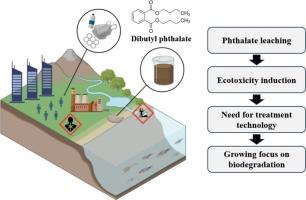Enhanced degradation of dibutyl phthalate using a synthetic mixed bacterial system and its impact on environmental toxicity
IF 8
1区 环境科学与生态学
Q1 ENVIRONMENTAL SCIENCES
引用次数: 0
Abstract
Dibutyl phthalate (DBP) is widely used in plastic manufacturing to enhance the flexibility and durability of products. However, DBP is a toxic, persistent environmental pollutant that poses significant risks to ecosystems and human health. This study investigates the DBP degradation efficiency of a mixed bacterial system (MBS) consisting of Serratia sp. G9, Bacillus sp. J7, and Serratia sp. J14, isolated from animal feces and oil-contaminated soil, and evaluates its environmental toxicity for potential practical application. The results show that the MBS exhibited significantly higher DBP removal efficiency and degradation rate compared to a single bacterial system (SBS), achieving near-complete removal of DBP (500 mg/L) within 7 days under optimal conditions. These conditions were determined to be an inoculum dose of 0.8 % (v/v), pH 7, temperature of 35 °C, and shaking speed of 120 rpm. Gas chromatography-mass spectrometry (GC–MS) analysis revealed the breakdown of DBP into non-toxic intermediates, and the degradation pathway was elucidated. Furthermore, aquatic toxicity and neurotoxicity assessments showed a significant reduction in toxicity after treatment, confirming the effectiveness of the MBS in mitigating the environmental impact of DBP pollution. Unlike previous studies that have focused solely on the biological treatability of DBP, this research emphasizes that the MBS offers an effective biological treatment strategy for DBP contamination and provides an environmentally friendly solution by significantly reducing environmental toxicity.

合成混合细菌系统对邻苯二甲酸二丁酯的强化降解及其对环境毒性的影响
邻苯二甲酸二丁酯(DBP)广泛用于塑料制造,以提高产品的柔韧性和耐用性。然而,DBP是一种有毒的持久性环境污染物,对生态系统和人类健康构成重大风险。本研究研究了从动物粪便和石油污染土壤中分离出的由沙雷氏菌G9、芽孢杆菌J7和沙雷氏菌J14组成的混合细菌系统(MBS)对DBP的降解效率,并对其环境毒性进行了评价。结果表明,与单一细菌系统(SBS)相比,MBS具有更高的DBP去除效率和降解率,在最佳条件下,MBS在7天内几乎完全去除DBP (500 mg/L)。接种量为0.8% (v/v), pH值为7,温度为35℃,震动速度为120 rpm。气相色谱-质谱(GC-MS)分析显示DBP分解为无毒中间体,并阐明了降解途径。此外,水生毒性和神经毒性评估显示,治疗后毒性显著降低,证实了MBS在减轻DBP污染的环境影响方面的有效性。与以往的研究只关注DBP的生物可治疗性不同,本研究强调MBS为DBP污染提供了一种有效的生物治疗策略,并通过显著降低环境毒性提供了一种环境友好的解决方案。
本文章由计算机程序翻译,如有差异,请以英文原文为准。
求助全文
约1分钟内获得全文
求助全文
来源期刊

Science of the Total Environment
环境科学-环境科学
CiteScore
17.60
自引率
10.20%
发文量
8726
审稿时长
2.4 months
期刊介绍:
The Science of the Total Environment is an international journal dedicated to scientific research on the environment and its interaction with humanity. It covers a wide range of disciplines and seeks to publish innovative, hypothesis-driven, and impactful research that explores the entire environment, including the atmosphere, lithosphere, hydrosphere, biosphere, and anthroposphere.
The journal's updated Aims & Scope emphasizes the importance of interdisciplinary environmental research with broad impact. Priority is given to studies that advance fundamental understanding and explore the interconnectedness of multiple environmental spheres. Field studies are preferred, while laboratory experiments must demonstrate significant methodological advancements or mechanistic insights with direct relevance to the environment.
 求助内容:
求助内容: 应助结果提醒方式:
应助结果提醒方式:


